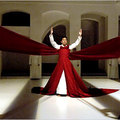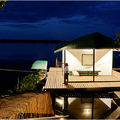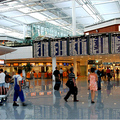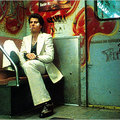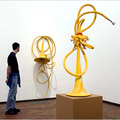At 12,000 Feet, Andean Culture Meets Pop Art
THE battered taxi climbed high above downtown La Paz, clattering over cobblestone streets toward the poor hillside neighborhoods where most of the city's Aymara Indians live. Then, as the pedestrian traffic thickened, I heard the sharp, clear notes of a brass band and clambered out of the cab into a mob of celebrants.
It was 4 p.m. on the last day of Carnaval for the people of the Munaypata barrio, and thousands had gathered in a plaza surrounded by squat brick buildings and dominated by the snow-crusted peak of Mount Illimani, La Paz's sacred symbol. In the center of the square, men clad in outlandishly sequined costumes swigged Huari beer and danced with cholas: indigenous women dressed in traditional black bowler hats and billowing, pleated dresses, known as polleras.
These Ch'uta dance festivities, to which an American expatriate friend had taken me, take place several times a year in the altiplano, Bolivia's high plateau, a barren region of llama herders, desert lakes and impoverished Aymara villages stretching west from the snowy peaks of the Andes. But nowhere is it more colorful than in La Paz, the country's 12,000-foot-high capital.
Here neighborhood associations and social organizations, known as fraternidades, compete to see who can put together the most extravagant costumes, most of which combine references to indigenous Aymara culture with a self-mocking twist. One group, for example, the Choleros, or Players, wore baby-blue vacquero costumes, complete with exaggeratedly flared pant legs and Pancho Villa hats. Another fraternity, known as the Intocables, or Untouchables, had decked themselves out as campy Dick Tracys, with fedoras and baggy orange suits adorned with bejeweled Andean motifs including condors and dragons. Many of the participants wore ghoulish masks with giant ears, bulbous green eyes and yellow beards. “It's all part of our tradition,” one beer-soaked member of the Intocables told me. “We all want to be the ones who get the most attention.”
A generation ago, fiestas like Ch'uta drew considerable attention from a group of young artists in La Paz. Partly inspired by the New York-based Pop Art movement, this circle began producing works filled with playful references to Aymara Indian culture: the festival masks, costumes and brightly colored fabrics that stand out sharply amid the washed-out landscapes of the altiplano. But while the Pop Art scene in New York was soon supplanted by other creative waves, it has never really disappeared from La Paz. And now the unique aesthetics of this city and the surrounding region have begun inspiring not just local artists, but also fashion designers and painters from the rest of South America and beyond.
Noted painters from the United States and Europe have come to La Paz to soak up the city's Andean atmosphere. The British designer John Galliano recently created a line based on the clothing of the Indian tribes of Bolivia and Peru, and last year the Buenos Aires fashion company Tramando introduced tops and skirts inspired by the “warmth, festivities and myths [and] rich chromatic nuances” of altiplano culture. Trixie d'Epanoux, a partner in Tramando, recently referred to La Paz as the Pop Art capital of South America.
The term is a tricky one. To some, Pop Art can refer to both the original Indian crafts and fashion designs — mischievous, bright, cartoonish and often kitschy — and to the evocations of those designs by contemporary artists. Others insist that the terminology can be applied only as Andy Warhol and Roy Lichtenstein meant it to be used — “high art” that uses elements of mass culture to make a creative statement.
“There is a marvelous, undeniably glorious repertoire of colors and forms in Bolivia, but they don't deserve the term Pop Art,” said Robert Valcárcel, a celebrated Bolivian artist, who has filled his paintings and collages with indigenous imagery. “I'm not trying to diminish the value of those cultural expressions, but to put them in a conceptual place.” Mr. Valcárcel prefers to call La Paz a “proto-Pop Art capital.”
Whatever one calls it, the sensibility is thriving in La Paz. Mr. Valcárcel is one of a handful of Bolivian artists whose work is widely displayed in galleries in other countries in South America and the United States — and though he moved to the lowland Bolivian city of Santa Cruz from La Paz 15 years ago, he has never really shaken off the altiplano influence. One evening I went to see some of his works at the lavishly decorated home of Patricia Tordoir, an English patron of the arts who has lived with her husband in La Paz for nearly two decades.
The founder of a gallery and nonprofit foundation, esART, in the affluent Zona Sur section, Ms. Tordoir has assembled what may be one of the largest contemporary Bolivian modern art collections in the world. She showed me some of Mr. Valcárcel's cartoonlike collages — a pair of fornicating Lacoste alligators, a Bolivian archangel in a billowing blue-and-orange checkerboard dress, each hand clutching a stick of dynamite (a reference to Bolivia's miners, who are prone to use the explosives both on the job and in confrontations with the government). Ms. Tordoir had also collected works spanning the long career of a Valcárcel contemporary, Gastón Ugalde. His works, including a takeoff of 1980s runaway inflation in Bolivia (a collage of a galloping steed pasted over reams of worthless Bolivian banknotes), are, she says, “the essence of the Pop Art sensibility.”
I visited Mr. Ugalde one afternoon at his studio in the bohemian neighborhood of Sopocachi just outside La Paz's center. A shaggy, bearded collagist, sculptor and photographer, Mr. Ugalde, 60, specializes in what may be the ultimate kitsch art: collage portraits assembled from coca leaf, Bolivia's most lucrative crop. (He forms patterns on the canvas by using the dark green surface of the leaf and its paler underside.)
The ascension in January 2006 to Bolivia's presidency of Evo Morales, an Aymara Indian who previously served as the head of a coca-growing syndicate in the country's Chapare region, has dramatically boosted Mr. Ugalde's profile and his fortunes. Shortly after his victory, Mr. Morales commissioned a coca-leaf presidential portrait, which now hangs prominently in the presidential palace along with Mr. Ugalde's coca portraits of Che Guevara and Simón Bolívar. Mr. Ugalde, who made his first coca portrait in 1992, told me that he was drawn to the leaf as an artistic medium because “traditionally we use coca leaf here to communicate. You chew it, you drink, and you talk. It brings people together.”
One of Mr. Ugalde's recent projects consists of a series of striking color photographs taken in the salt flat of Uyuni, eight hours south of La Paz, which juxtapose stark landscapes with uniquely Bolivian cultural artifacts. In one photograph, a transparency of Che Guevara — shot dead by Bolivian troops in the jungle near Santa Cruz in 1967 and still revered by many here — is submerged in the turquoise waters of a puddle in the enormous Uyuni salt flat. In another, Mr. Ugalde has wrapped, Christo-style, a rusting, abandoned mining train in a colorful Andean fabric, transforming a bleak symbol of economic collapse (most of the altiplano mines shut down a generation ago) into a celebration of Andean tradition. “Andeans are among the richest artisan cultures in the world,” Mr. Ugalde told me. “Now the concepts of artist and artisan have come together.”
ONE evening friends took me to Gota de Agua, a popular club for traditional Bolivian folkloric music, where artists, moviemakers and other creative types from Bolivia and abroad go to soak up La Paz's Aymara aesthetic. At midnight, it was packed: an Andean band, playing pipes and drums and wearing the distinctive peaked alpaca caps with earflaps, took to the dance floor, surrounded by Bolivian cultural artifacts — bright murals of peasants in multicolored headdresses, masks of black slave miners with pipes, red beards and helmets (the central motif of the morenada dance, one of the most popular in the annual Gran Poder festival in La Paz). Bolivian fashionistas, video artists and heavy metal rockers mingled over half-liter bottles of Huari beer and danced to both live and recorded Bolivian music.
The night I was there, a dozen young French travelers walked through the door, most of them clad in exaggerated versions of traditional Bolivian fashions — one young woman wore an African-style Moslem cap in alpaca with vertical thin strips in shades of green and gray, and a matching poncho with vertical and horizontal bands of bright colors running into each other. “We love the colors and the patterns,” she told me. Growing numbers of young French tourists were discovering Bolivia, she said, drawn by its Andean aesthetic and its changing politics. “Evo Morales has put Bolivia on the map,” she said. “We like it because it's socialist, indigenous and cheap.”
Just up the hill from Gota de Agua stands another establishment that has become popular among the artsy set: La Costilla de Adán, or Adam's Rib, a bar in Sopocachi. The owner, Roberto Cazorla Guzman, a hair stylist, opened the two-story place in what was his home. He has crammed it with curios and artifacts spanning the past century, some indigenously Bolivian, others “found art” he picked up at a flea market that takes place every Thursday and Sunday in gray, windswept El Alto, 1,500 feet above La Paz.
Mr. Cazorla Guzman took me upstairs and showed off his collection of negritas — black female dolls that originated during the Spanish colonial era when upper-class Bolivian women used African slaves as wet nurses. The dolls, now embraced as symbols of fecundity, are traditionally brought out for La Paz's annual Alasitas Festival. The owner told me that he designed his bar-club as “a house of creative inspiration.”
For all of its dazzling visual imagery, La Paz remains an artistic backwater. Government financing for artists is nonexistent, and the domestic market in this poor country is so limited that even an artist of the stature of Roberto Valcárcel must support himself by teaching. That is what troubles Mr. Valcárcel most about calling La Paz a Pop Art capital — it wrongly implies, he says, both a thriving contemporary art scene and an aesthetic that is “still imitating the New York Pop artists” 40 years late.
As an inspiration for graphic design and fashion, La Paz may be one of the hottest scenes around. But for the handful of local artists trying to survive here, it can be a very cold place indeed.
VISITOR INFORMATION
GETTING THERE
American Airlines operates flights between Kennedy Airport in New York and La Paz via Miami. Flights for mid-June were recently available starting at $600, with a two-hour layover in Miami on the way down, and stops in Santa Cruz, Bolivia, and Miami on the way back.
Last New Year's Eve, Bolivia's Congress passed a law requiring United States citizens to obtain tourist visas, but most Bolivian embassies were not equipped to implement the new requirement, and as of mid-May the law still hadn't gone into effect. Check with your local Bolivian consulate or the embassy to determine what the rules are. The currency is the boliviano, but U.S. dollars are accepted in most hotels and restaurants.
HOTELS
Hostal República (Calle Commercio 145 in the Central District; 591-2-220-2742; www.hostalrepublica.com) is a beautiful colonial-style villa that was once the home of a president of the republic. It's walking distance from the Plaza Murillo, where the presidential palace is now situated; doubles with private bath, $26.
Somewhat more upscale is the three-star Eva Palace Hotel (Calle Sagarnaga 173, Central District; 591-2-231-4885; www.evapalacehotel.com), in the heart of La Paz's bustling tourist district, is just up the street from the Plaza San Francisco. Doubles from $38.
Hotel Radisson (Avenida Arce 2177; 591-2-244-1111; www.radisson.com/lapazbo) in Sopacachi, just up the road from the United States Embassy, is a clean, modern, comfortable hotel with a decent restaurant and high-speed Internet access. Doubles from $180.
RESTAURANTS AND BARS
Bocaisapo (Final Indaburo, around the corner from Calle Jaen, in Casa Verde de la Cruz) is a popular wine bar frequented by La Paz's artists and writers. It features traditional Bolivian music and heated discussions about art, literature and Andean culture at its heavy wooden tables and lambskin-covered benches.
Costilla de Adán (Pasaje Aspiazu 743, between Calle Aspiazu and Avenida Abdon Saavedra; 591-2-241-2318) opened six months ago and quickly became one of the most popular bars in town. Its lively half-dozen lounges spread over two floors are crammed with Pop Art and Bolivian artifacts.
Gota de Agua (Calle Ilampu 837, between Sagarnaga and Santa Cruz), one of La Paz's hottest clubs, features traditional Bolivian music, both live and recorded, in a traditional Andean milieu. On weekends the beer flows and the dancing goes on until dawn. Cover charge varies depending on the entertainment, but isn't more than $2.
Los Tumbos del Sur (Avenida Costanero 60, Seguencoma District; 591-2-275-2037) serves large helpings of traditional Bolivian food, as does La Casa de los Paceños (Avenida Sucre 814; 591-2-228-0955). Dinner for two is $20 to $25 at either.
La Comedie (Pasaje Gustavo Medinacelli 2234; 591-2-242-3561) in Sopacachi, which serves French cuisine, is widely regarded as the best restaurant in town. Dinner for two costs less than $40.


